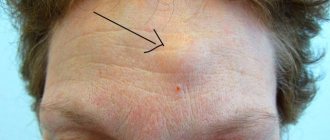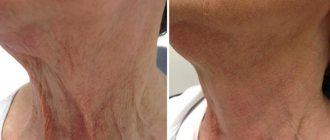How to increase hair thickness using the HFE method
According to statistics, an average of about 100,000 hairs grow on a person’s head. Blondes have the thickest hair - they have about 130,000 hairs. Redheads have the least dense hair - up to 80,000 per head. However, with less density, the hair may look fuller due to its thickness. To determine the thickness of the hair, you need to look at the width of the parting: the more clearly the scalp is visible, the thinner the hair.
The results of a trichological examination will allow you to choose the right treatment tactics, aimed either at increasing hair thickness or density.
First experiments
Isabelle Dinoire after surgery
The first face transplant was performed by French surgeons on November 27, 2005. A patient named Isabelle Dinoire. Her story of loss was quite eerie. Having passed out after taking a large dose of sleeping pills, she practically lost the lower part of her face (part of her cheek, nose, lips and chin), chewed by her own dog.
The tissue deficit was so great that it was impossible to restore them. Then the surgeons decided to transplant Isabelle's donor lips, chin and nose.
The first complete facial reconstruction was carried out by Spanish doctors only 5 years later, in 2010. The scars formed as a result of the gunshot wound did not allow the victim to eat, talk, or breathe normally. The man underwent several operations in stages - the throat was reconstructed, the middle part of the face - cheekbones, nose, the lower part - jaws with teeth; skin covering.
Types of skin plastic surgery
There are two basic options for plastic surgery:
- free (a skin graft completely cut off from the donor area is used for transplantation);
- non-free (the wound is either closed using the adjacent skin with or without additional incisions, or a pedicle flap is used).
A pedicle flap is a piece of skin along with subcutaneous fat, separated from the base and tissues so that it is connected to them only in a limited area. It is called the feeding pedicle; through it the blood supply to the flap occurs.
In addition, a distinction is made between primary and secondary transplantation. Primary transplantation involves the closure of fresh wounds (after injuries, operations), accompanied by heavy loss of blood. This method is combined with other types of plastic surgery. Secondary transplantation is used to correct pathologies resulting from excision of granulating wounds. Used more often for the head, including the face and neck.
A granulating wound is a wound whose cavity is filled with granulation tissue (heals by secondary intention).
Finger plastic surgery
Difficulties of face transplantation
Transplantation of facial tissue is indicated only when reconstructive plastic interventions are impossible due to large tissue loss.
The first difficulty is the intervention itself. The essence is this: each organ (nose, eyelids, lips) is returned to its normal size and place, and in the absence of an organ, doctors form it anew. The operation is considered difficult for surgeons and risky for the patient. During transplantation, severed nerves, blood vessels, and transplanted parts of the face are connected, and the formations begin to work as if they were their own.
According to reconstructive surgery specialists, in the future, face transplantation will become a routine plastic intervention. Anyone can afford a transplant. However, other doctors believe that this operation is too complex to become routine.
The second difficulty is finding a suitable donor skin flap. It is taken from people who are related by blood to the patient, or it can be cadaveric material. If the lesion is deep, then not only skin flaps are required, but also bone flaps (i.e., bone fragments). Bone tissue is collected only from corpses.
Donor organs and tissues must be compatible with the tissues of the recipient (patient). Otherwise, rejection will begin.
The third difficulty, which is also the main one, is the process of transplant rejection. The host's immune system recognizes the transplanted tissue as foreign and attacks it. As a result, all the painstaking work of doctors goes down the drain. To avoid this, the tissue compatibility of the donor and recipient is carefully examined.
The fourth difficulty: even with close to ideal compatibility, the patient will take drugs that suppress his immune system for life in order to prevent immune aggression against the transplanted tissue.
Indications for hair transplant
Scalp hair transplantation in men is prescribed in the later stages of androgenetic alopecia, when the follicles are covered with epithelium and become unable to produce hair even when pathogenic hormonal influences are excluded and blood flow in the scalp is stimulated.
With cicatricial apoptia of a traumatic nature, the activity of the follicles also fades irreversibly, and this can only be corrected by surgical intervention.
In these two forms of baldness, only part of the scalp is lost, leaving healthy areas that can serve as a donor area during surgery.
Note: the method is not intended for the treatment of alopecia areata, since it is caused by pathologies of the immune system, and not by direct damage to the scalp. Transplantation is also not performed for diffuse alopecia, since here the baldness does not have a pronounced focus.
Where do donor material come from?
A tissue donor becomes a patient who has been diagnosed as brain dead, or a person who has just died in a traffic accident or under other circumstances. In other words, the facial part can be taken from a person (with an uninjured face, of course) who has recently died or someone whose life is supported only by devices.
Finding a suitable donor is a lengthy process. The donor and the patient must have the same gender, the same blood type, and approximately equal size of the facial part of the skull and face as a whole. The tissues of the donor and the future carrier of the new person must be compatible in antigenic structure. It is necessary to make sure that the donor does not have chronic diseases or previous viral infections.
There are also legal subtleties of donation. The consent of relatives, certified by law, is necessary; the deceased himself during his lifetime should not express disagreement with the idea of organ donation or leave written evidence of this.
The death of the future donor is certified by a forensic expert. Only then can the transplant team begin to work.
The collected material must be transported in accordance with all rules. Otherwise, processes of necrosis may begin in it, and then normal engraftment of the flap is impossible.
How is the operation performed?
- Anesthesia is given.
- Cellophane is applied to the surface of the wound to mark the boundaries of the area and obtain a pattern for donor material.
- A piece of skin of the desired type is cut out.
- The graft is passed through a drum to form the desired thickness.
- A skin flap is applied to the wound, which is in a folded form (to prevent damage to the fibers).
- The edges of the manipulation site are sutured.
The donor surface is processed according to the following algorithm:
- Stopping bleeding;
- Applying a bandage with antimicrobial impregnation;
- Suturing the wound.
If necessary, use a splint or plaster.
Procedure for performing transplantation
A complete transplant makes it possible to transplant all the muscles, skin, bone fragments, nerves and blood vessels into the victim.
This operation remains experimental due to the small number of interventions. However, an approximate procedure for its implementation has already been established.
- A thorough examination of the future recipient, on the basis of which a final opinion is made on the presence of indications for the intervention.
- Creating a 3D model of the future face and drawing up a surgical intervention plan.
- Entering the patient's data on the transplant waiting list; selection of the most compatible donor.
- Taking a donor face. The patient is taken to the operating room; in the adjacent operating room they will work with cadaveric material. The collection of donor material is carried out by one medical team, while another team cares for the patient.
Interesting: A single organ transplant may involve a team of ~30 surgeons and other medical professionals.
- Direct face transplant.
The facial donor material is moved to the main operating room and the transplant begins. To perform a face transplant, doctors perform jewelry work by sewing together the ends of blood vessels. If the transplant takes on a pink color, it means that the patient’s blood is successfully supplied to it.
Then they connect the facial muscles, their tendons, and the fibers of the nerves that are represented on the face. At the very end, the skin is sewn together.
Methods used to connect tissue fragments:
- gluing;
- sewing, as well as stitching with various suture materials;
- exposure to a green spectrum laser (to bond the skin and subcutaneous fat to the underlying muscles).
Facial transplantation is a long-term operation, sometimes taking up to 1.5 days. Members of the operating team must have excellent surgical technique and great endurance. Sometimes several dozen medical workers may be involved in the operation due to the length of the transplant.
Approximate prices
How much does hair transplant cost for men? The cost of hair transplantation for men depends on the authority and qualifications of the clinic staff , as well as on the transplantation method.
Typically, clinics indicate the price for transplanting one graft; to get the full cost of the procedure, you should multiply it by the total number of grafts, add to this the prices of the necessary medications and hospitalization for 2-5 days.
The number of transplanted grafts is determined by the stage of baldness (from 1500 at stage 3 to 10,000 at stage seven).
The table provides a brief summary of hair transplant prices for men.
| Clinic | Price per graft, rub. |
| St. Petersburg, “City Medical Center” | 40 with patch method, 60 with FUE |
| Moscow, "Inteko" | 80 for patchwork, 130 for FUE |
| Rostov-on-Don, "GraftClinic" | 75 for patchwork, 110 for FUE |
| "Real Trans Hair", Moscow | From 120 thousand for the entire operation |
| Ekaterinburg, "Linline" | 225,000 for the third degree of alopecia, 260,000 for the fourth, 300,000 for the fifth (for the entire operation) |
| Cyprus, "Hdc" | $3 for patchwork, $4.6 for FUE |
| Türkiye, Medicana International | From 2000 euros for the entire operation. |
After transplant
The patient is prescribed immunosuppressants for life—medicines that suppress his immune system. This prevents the new face from being rejected.
The problem is that reduced immunity leads to the development of various infectious diseases. For this reason, the patient is prescribed simultaneous administration of several antibiotic drugs for a period of 12 months. After this period, some of the antibacterial agents must be discontinued, and some will be used by the patient for life.
Long-term use of immunosuppressants leads not only to infectious complications. Such patients are prone to developing cancer and kidney pathology.
After transplantation, medications are required to prevent scar formation.
It takes a very long time for tissue sensitivity to be restored, as well as functional capabilities (eating, articulating normally when speaking, re-mastering facial muscles).
Psychological disorders are also common in patients who have undergone a face transplant. They look at themselves in the mirror and see someone else's face. For this reason, assistance from a psychologist and psychiatrist is provided in the postoperative period.
Free skin grafting
Free skin grafting is divided into:
- vascularized;
- nonvascularized.
Vascularized
To perform such plastic surgery, microsurgical instruments, suture material, an operating surgical microscope and a complex flap for transplantation are used.
The flap is complex because the vascular network is preserved in it, and during transplantation it is anastomosed (connected) with the vessels of the affected limb of a person.
Vascularization is the formation of new vessels (usually capillaries) inside the tissue.
Nonvascularized
Initially, small pieces of the epidermis were used to perform such plastic surgery, but now this practice is rare.
Currently, thanks to the invention of a special medical instrument - a dermatome - it is possible to take and transplant large areas of skin (Thirsch skin grafting).
layered flaps , which cover the entire depth of the dermis, and split flaps , which contain only the superficial layers of the epidermis. After the transplant, the site where the layer-by-layer donor flap is taken is subjected to secondary plastic surgery, but after the split flap is taken, this is not necessary, since the new epithelium forms independently thanks to the preserved skin appendages.
Face transplant: pros and cons
Face transplant surgery is only necessary for those whose defects cannot be corrected by reconstructive plastic surgery. These are patients with disfigured faces as a result of burns (the majority), chemical burns, animal bites, and wounds to the face.
Transplantation restores facial expressions and functional abilities by 80%. In other words, patients again smile, frown, talk normally, and eat with a spoon and fork.
The ethical side of the matter is still being discussed. Some experts believe that defects present on the facial part (with the exception of deformity) do not interfere with the normal functioning of the human body. This view of the problem does not take into account the difficult mental state of disfigured people. Most of them were diagnosed with severe depression. Many attempted suicides have been recorded. For this reason, facial transplantation, despite its experimental status, is recognized as a necessary operation in cases of facial disfigurement.
How does transplanted hair survive?
Since the hair, roughly speaking, is simply inserted into the holes, it needs to be fixed somehow. It would seem logical to use bandages to prevent the hair from falling out as soon as the wind blows or the patient shakes his head. In fact, this is not necessary at all, since the hair holds on perfectly with the help of natural glue - the protein fibrin.
This is how the transplant area is designated before surgery.
This fixation, combined with the low-traumatic nature of the procedure, in which anesthesia, if used, is local, allows the patient to go home on the same day.
Depending on your hair type and color, within a year you will be able to evaluate the results and be surprised at how modern medicine works.
Successful transplants
A disfigured person is inspired to take the long road to face transplantation and rehabilitation by examples of successful cures. Of course, it is not possible at the moment to return to the previous appearance. However, modern transplantation is capable of transplanting a face from a donor and restoring important functions that are necessary for life.
Katie Stubblefield
In 2014, a young American woman (18 years old) attempted to take her own life, which left her without a nose, jaw, and part of her forehead. Within 1.5 days (31 hours), a complete face transplant operation took place, and Katie Stubblefield received a completely new appearance.
Before the transplant, the girl underwent 22 reconstructive interventions: her jaw bones were restored using a fragment of the femur and 3D printed bone flaps. After transplantation, 3 additional operations were performed. As a result, Katie gained a new look.
Photo of Katie Stubblefield before the shot and after the operation
Patrick Hardison
Patrick Hardison severely burned his face in 2001. The transplantation was completed only in 2020. The result of a face transplant is an almost normal appearance; in a hat and glasses, a man cannot be distinguished from an ordinary passerby.
Patrick Hardison before surgery and now
Nikolay Egorkin – face transplant in Russia
Nikolai Egorkin after face transplant
Russian Nikolai Yegorkin received severe electrical burns while performing compulsory military service in 2012. He lost his nose, part of his forehead; the right side of the neck and face was deformed, and defects of the skull bones appeared. The limbs on the right side of the body (leg and arm) were also injured. The private underwent more than 30 reconstructive surgeries. Finally, it was decided to do a face transplant - the first face transplant in Russia. The operation was performed by a team of doctors under the leadership of Maria Volokh, chief plastic surgeon of the Northwestern Federal District.
Donor material was taken from a man who died from a TBI. As a result, the victim's face was successfully restored.
Cameron Underwood
Cameron Underwood injured his lower jaw, teeth, and nose from a gunshot wound. The young man underwent a face transplant at the beginning of 2020. The result was stunning. All teeth, palate, gums, as well as the bone part of the jaws, nasal cavity and nose, cheeks, eyelids were restored.
Similar articles on the topic of transplantation
- Facial lipofilling: before and after photos
- Liver transplantation: indications, how...
- Liver transplant in Novosibirsk
- Liver transplant in Nizhny Novgorod
- Liver transplant in Yekaterinburg
- Hand transplant: history, photo, price
How to transplant hair
Without going into too much detail, hair transplantation is precisely a transplantation in the truest sense of the word. A team of doctors, usually consisting of more than eight people, takes hair from one area and inserts it into another during a multi-hour operation. Sometimes the operation time reaches 8 hours or more, and during this time up to 5,000 follicles are transplanted. As a rule, follicles are taken in the form of follicular units of 2-4 follicles (rarely more). The associations have one power system and it is in this format that it is easier to transplant them.
The hair follicle (lat. folliculus pili, also hair follicle) is a dynamic organ located in the dermal layer of mammalian skin and consists of 20 different types of cells with different functions.
Small pieces of tissue called grafts are used for transplantation. Depending on the transplantation method, the grafts are removed by the surgeon manually or using a special tool, which speeds up the work and reduces the percentage of defects. This method is used when more than 3000 grafts are transplanted. The size of the grafts is about 0.6-1 mm in diameter. At earlier stages larger “calibers” were used. As a result, the patient's head often began to look like a doll's, with the hair growing in tufts.
Already in 1936, Suji Okuda said that the smaller the size of the graft, the better the result.
Once the grafts are removed, the surgeon's assistants take care of them. They sort them by type and best suited to each specific zone. Sometimes hair is used for transplantation not from the occipital or temporal region, but also from the chest, legs and other parts of the body. In this case, only your own hair is suitable. The body is designed in such a way that foreign hair does not take root. This has been proven many times through various experiments and studies.
This is what the graft collection site looks like. In a few days everything will heal, and a little later new hair will grow.
Once Grafts are sorted, they can be placed in new locations. To do this, there is another tool that makes small punctures into which the follicles are placed.
With this method of operation, there are almost no scars left in the places from which the grafts were taken. Even on a shaved head it is almost unnoticeable. Over time, the follicles in the donor areas are restored, and the area becomes overgrown with hair again. The procedure does not remove hair from the donor area.
If you need to transplant a lot of hair, there is another way. It involves cutting larger pieces than conventional grafts. To do this, tissue flaps are taken, which are then cut into grafts and transplanted to the desired areas.
Laser for forehead correction
Thermal radiation will help improve the hairline for both high and low foreheads:
- If it is narrow, laser hair removal is performed. Radiation in several sessions will get rid of excess hair, weakening its follicles. The laser procedure is done in 15, 20 minutes; it will help to even out the upper border of the forehead, hiding bald spots, eliminating the unsightly little toe in the center. With its help, the shape of the hairline is changed to a more suitable one. To achieve the effect, 4-8 sessions are needed with pauses of 3-4 weeks.
- If the forehead is too high, a low-intensity, “cold” laser can be used. Radiation stimulates the growth of vellus hair at its upper border. It awakens “dormant” follicles, increases blood circulation in this area, supplying the bulbs with oxygen, and promotes cell development. This stimulates hair growth, increases its density, allows you to correct the shape of the forehead and reduce its height.
The procedures are done twice a week for 3-6 months. They are absolutely painless.
Watch this video about laser hair removal of the forehead area:
Why does everyone go to Turkey for new hair?
There are more clinics in Turkey and prices are lower. In Istanbul alone there are several dozen hair transplant centers.
Many of these centers have been operating for 20 years. Up to a dozen transplants are made per day in the center of the middle arm. Up to 60 thousand people come for the procedure annually .
But there are no queues. You can come any day, having previously called the clinic, and leave with new hair. At the same time, relax and see the sights.
Finally, many Turkish clinics include in the cost of the procedure several days of accommodation in a 4-5* hotel, transfers from the airport, tests, medications, skincare products, etc.
Rehabilitation
The duration and complexity of the rehabilitation period depends on the chosen method, the amount of hair transplanted and the characteristics of the patient himself. Painful sensations after a patch transplant can last up to 1-2 months; with other methods they disappear after one to two weeks.
After transplantation using FUE and FUT methods, swelling may be observed, which usually disappears within a few weeks. As a rule, hospitalization is not required, but the patient will have to wear a bandage for the first few days (if incisions and punctures were made).
It may take several months for the hair to heal. And the results can be assessed a year after the procedure.
What else do you need to know?
In order to compete with each other, some Turkish clinics are forced to save on specialists. As a result, the patient is advised by an experienced doctor, and the transplant is performed by nurses. The doctor intervenes only as a last resort.
There is also a black market for hair transplants. These are illegal clinics that lure in with beautiful websites and low prices. But in the end, at best, you will have to repeat the procedure. At worst, they can cause blood poisoning.
To be sure of the result, you need to contact a clinic that has membership in ISHRS. This is the International Society of Hair Restoration Surgery, a world-class association.
How much hair will survive
On average, up to 95% of follicles survive. But everything very much depends on the qualifications of the doctor and the patient’s condition.
After a couple of weeks, some of the transplanted hair will fall out. But this is a natural update. The main thing is that the follicles will remain in place.
In general, a 100% guarantee on all follicles is a myth. Firstly, 3-6% of follicles will be lost before transplantation. Secondly, no one will count the transplanted hairs.
With artificial hair everything is sadder. About 10-20% of hairs fall out every year. You will have to adjust your hairstyle every 2-4 years.











